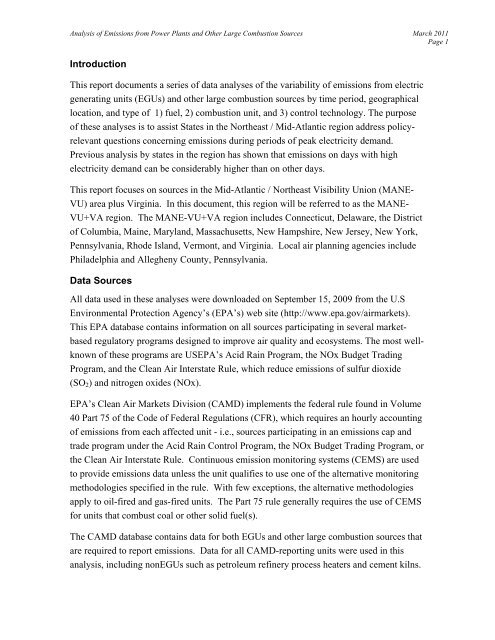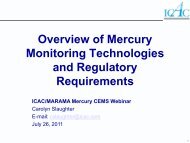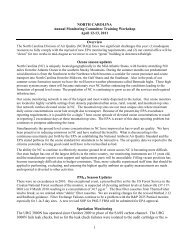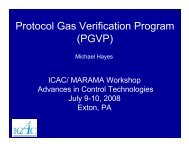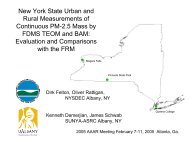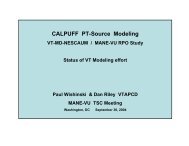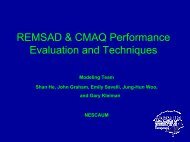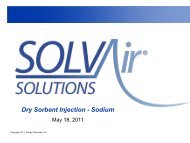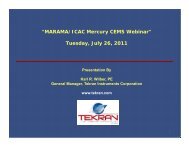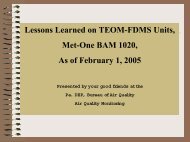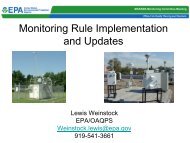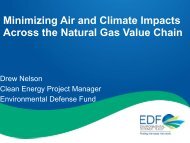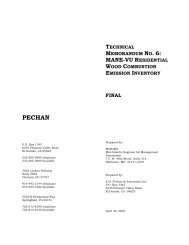Analysis of 2007 Emissions from Power Plants and Other ... - MARAMA
Analysis of 2007 Emissions from Power Plants and Other ... - MARAMA
Analysis of 2007 Emissions from Power Plants and Other ... - MARAMA
You also want an ePaper? Increase the reach of your titles
YUMPU automatically turns print PDFs into web optimized ePapers that Google loves.
<strong>Analysis</strong> <strong>of</strong> <strong>Emissions</strong> <strong>from</strong> <strong>Power</strong> <strong>Plants</strong> <strong>and</strong> <strong>Other</strong> Large Combustion Sources March 2011Page 1IntroductionThis report documents a series <strong>of</strong> data analyses <strong>of</strong> the variability <strong>of</strong> emissions <strong>from</strong> electricgenerating units (EGUs) <strong>and</strong> other large combustion sources by time period, geographicallocation, <strong>and</strong> type <strong>of</strong> 1) fuel, 2) combustion unit, <strong>and</strong> 3) control technology. The purpose<strong>of</strong> these analyses is to assist States in the Northeast / Mid-Atlantic region address policyrelevantquestions concerning emissions during periods <strong>of</strong> peak electricity dem<strong>and</strong>.Previous analysis by states in the region has shown that emissions on days with highelectricity dem<strong>and</strong> can be considerably higher than on other days.This report focuses on sources in the Mid-Atlantic / Northeast Visibility Union (MANE-VU) area plus Virginia. In this document, this region will be referred to as the MANE-VU+VA region. The MANE-VU+VA region includes Connecticut, Delaware, the District<strong>of</strong> Columbia, Maine, Maryl<strong>and</strong>, Massachusetts, New Hampshire, New Jersey, New York,Pennsylvania, Rhode Isl<strong>and</strong>, Vermont, <strong>and</strong> Virginia. Local air planning agencies includePhiladelphia <strong>and</strong> Allegheny County, Pennsylvania.Data SourcesAll data used in these analyses were downloaded on September 15, 2009 <strong>from</strong> the U.SEnvironmental Protection Agency’s (EPA’s) web site (http://www.epa.gov/airmarkets).This EPA database contains information on all sources participating in several marketbasedregulatory programs designed to improve air quality <strong>and</strong> ecosystems. The most wellknown<strong>of</strong> these programs are USEPA’s Acid Rain Program, the NOx Budget TradingProgram, <strong>and</strong> the Clean Air Interstate Rule, which reduce emissions <strong>of</strong> sulfur dioxide(SO 2 ) <strong>and</strong> nitrogen oxides (NOx).EPA’s Clean Air Markets Division (CAMD) implements the federal rule found in Volume40 Part 75 <strong>of</strong> the Code <strong>of</strong> Federal Regulations (CFR), which requires an hourly accounting<strong>of</strong> emissions <strong>from</strong> each affected unit - i.e., sources participating in an emissions cap <strong>and</strong>trade program under the Acid Rain Control Program, the NOx Budget Trading Program, orthe Clean Air Interstate Rule. Continuous emission monitoring systems (CEMS) are usedto provide emissions data unless the unit qualifies to use one <strong>of</strong> the alternative monitoringmethodologies specified in the rule. With few exceptions, the alternative methodologiesapply to oil-fired <strong>and</strong> gas-fired units. The Part 75 rule generally requires the use <strong>of</strong> CEMSfor units that combust coal or other solid fuel(s).The CAMD database contains data for both EGUs <strong>and</strong> other large combustion sources thatare required to report emissions. Data for all CAMD-reporting units were used in thisanalysis, including nonEGUs such as petroleum refinery process heaters <strong>and</strong> cement kilns.


